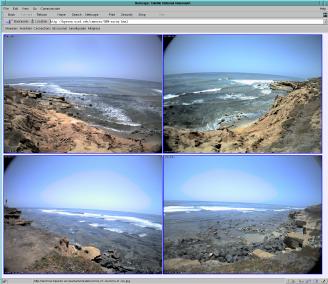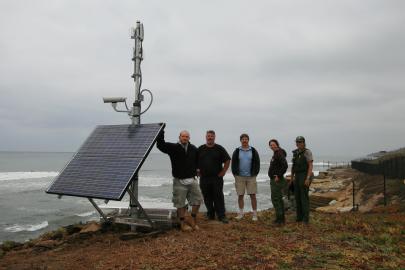
|
|
June 12, 2007 Cabrillo National Monument tidepool camera images and time lapse animations accessible via HPWREN, distance education to follow
On June 11, 2007, the installation of two sets of cameras was completed at Cabrillo National Monument, on the Point Loma peninsula in San Diego. These cameras show the highly valued rocky intertidal areas managed by the National Park Service (NPS). The cameras are deployed on two solar stations designed by HPWREN and the San Diego State University (SDSU) Field Station Programs. The first set of NPS cameras on a HPWREN solar station faces the southern portion of the peninsula, while the other northern site shows the most common access point used by park visitors. All four cameras are visible on public web sites, including at /cameras/CNM.html. The HPWREN and the NPS partnership was coordinated by Susan Teel through the California Mediterranean Research Learning Center and is continuing to work towards an installation at other parks related to project participants, specifically the Santa Monica Mountains National Recreation Area and the Channel Islands National Park. HPWREN, University of California San Diego, SDSU Field Station Programs, NPS, U.S. Navy, and U.S. Coast Guard staff worked jointly to implement this program. The National Park Service will use these cameras for multiple purposes ranging from education to environmental monitoring and research. The HPWREN network has enabled the NPS to use the Live Interactive Virtual Exploration (LIVE) system, developed by HPWREN. A distance education system previously installed by Nebraska Schools was further enhanced and routed through this network. These education programs allow students in classrooms around the nation to interact with Rangers or Scientists live via an Internet connection. The HPWREN LIVE system allows tremendous and untethered mobility for the presenter to conduct virtual programs anywhere in the park, including at the Old Point Loma Lighthouse or the Juan Rodríguez Cabrillo exhibit. In December 2006, HPWREN and SDSU Field Stations Program staff assisted NPS rangers and conducted a trial LIVE session from the rocky intertidal zones with students at the California Science Center in Los Angeles and at South Broward High Marine Magnet Program and New River Middle Schools in Florida, utilizing interactive communication with an NPS interpreter, as well as communicating with a small underwater remotely operated vehicle. NPS has received requests from schools regionally as well as from other states (e.g., Nebraska) for similar education programs. The cameras will also assist the NPS staff to determine more accurate numbers of visitors in the tidepools on a year-round basis and to use this information to more effectively manage and protect this popular site for visitors. Future plans include displaying the information at the Park's Visitor Center to increase virtual accessibility for those visitors to experience the tidepools who might not be able to otherwise (e.g., physical limitations). Possible research questions include evaluating seasonal and annual sand deposition rates and erosion. The National Oceanic and Atmospheric Administration (NOAA) expects to use these cameras sites in coordination with an automated weather station at the park.
More installation photos can be found at:
Andrea K. N. Compton
|



